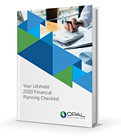New SECURE 2.0 Retirement Bill Could Be a Game Changer
By Jesse Giordano, CFP® | April 28, 2022Saving early and often is the golden rule for retirement planning. New legislation currently making its way through Congress would make it easier to do just that. The Securing a Strong Retirement Act of 2022 (also known as SECURE 2.0) is an extension of the SECURE Act that passed in 2019. The new legislation calls for significant reforms that could help everyday Americans supercharge their nest eggs.
SECURE 2.0 passed the House in late March and is currently awaiting approval from the Senate. If it passes, we can expect some big changes when it comes to retirement planning. Let’s take a closer look at what’s on the table.

Most Employers Would Auto-Enroll Workers into Retirement Plans
Research shows that participation goes way up when new employees are automatically funneled into employer-sponsored retirement plans. According to the Pew Charitable Trusts, participation rates are often above 90%. That rate drops to around 50% when employees have to do the work of opting in themselves.
The new bill would automatically enroll participants at a rate of 3%. From there, the rate would bump up by 1% every year, maxing out at 10%. Workers always have the option of canceling, but the structure could help lots of folks prioritize retirement without having to take any action.
Small businesses with 10 or fewer employees would be exempt. The same goes for businesses that are less than three years old. Tax credits of up to $1,000 per employee would be available to companies that do participate.
Required Minimum Distributions Would Change
When you put money into a tax-deferred account like a 401(k) or traditional IRA, you get to enjoy a tax deduction today. This effectively reduces your taxable income during your working years. The catch is that you’ll be taxed on withdrawals you make in retirement. The IRS requires you to begin taking required minimum distributions (RMDs) at age 72, but that would change under the new SECURE 2.0 plan. If passed as is, it will increase the RMD age to:
- 73 in 2023
- 74 in 2030
- 75 in 2033
It’s a move that would allow you to keep your money invested—and growing—for longer. If you don’t need to take distributions before the RMD age, you don’t have to.
401(k) Catch-Up Contributions Would Increase
Folks who are 50 and older are allowed to kick in more to their 401(k)s. These catch-up contributions currently top off at $6,500 in 2022. SECURE 2.0 proposes dialing that up to $10,000 if you’re 62 to 64 years old.
Workers Could Receive Student Loan Support
There’s been a lot of buzz lately around student loan cancellation. Time will tell how that will unfold, but if passed, SECURE 2.0 would allow employers to make 401(k) contributions that match their workers’ student loan payments. This would make it easier for employees to save for retirement while paying down their student debt—instead of it being an either/or situation.
Domestic Abuse Survivors Could Take Early Withdrawals
Ordinarily, you’ll incur a 10% penalty for tapping your tax-deferred retirement accounts before age 59½. If the new legislation passes, that fee would be waived for recent domestic abuse survivors who withdraw up to $10,000. They would still be taxed on these distributions, but they’ll have the option of paying the liability over a three-year period. These proposals could financially empower domestic abuse survivors and enable them to leave dangerous relationships.
What It All Means for Your Retirement
Again, the Securing a Strong Retirement Act of 2022 has not yet been signed into law. While the House has given it the greenlight, it still needs to be approved by the Senate. In the meantime, Opal Wealth Advisors will be watching closely to see how things progress. It would certainly unlock valuable retirement planning benefits. With that said, it’s never a bad time to check in on your long-term saving strategy. Schedule a call with us today to arrange a personalized review of your retirement plan.
Be a Smart Investor
Stay up-to-date with industry-leading information and news delivered straight to your inbox.
Get our timely insights delivered to your inbox (Blog)
Please remember that past performance may not be indicative of future results. Different types of investments involve varying degrees of risk, and there can be no assurance that the future performance of any specific investment, investment strategy, or product (including the investments and/or investment strategies recommended or undertaken by Opal Wealth Advisors, LLC [“OWA]), or any non-investment related content, made reference to directly or indirectly in this commentary will be profitable, equal any corresponding indicated historical performance level(s), be suitable for your portfolio or individual situation, or prove successful. Due to various factors, including changing market conditions and/or applicable laws, the content may no longer be reflective of current opinions or positions. Moreover, you should not assume that any discussion or information contained in this commentary serves as the receipt of, or as a substitute for, personalized investment advice from OWA. OWA is neither a law firm, nor a certified public accounting firm, and no portion of the commentary content should be construed as legal or accounting advice. A copy of the OWA’s current written disclosure Brochure discussing our advisory services and fees continues to remain available upon request or at www.opalwealthadvisors.com. Please Remember: If you are a OWA client, please contact OWA, in writing, if there are any changes in your personal/financial situation or investment objectives for the purpose of reviewing/evaluating/revising our previous recommendations and/or services, or if you would like to impose, add, or to modify any reasonable restrictions to our investment advisory services. Unless, and until, you notify us, in writing, to the contrary, we shall continue to provide services as we do currently. Please Also Remember to advise us if you have not been receiving account statements (at least quarterly) from the account custodian.



